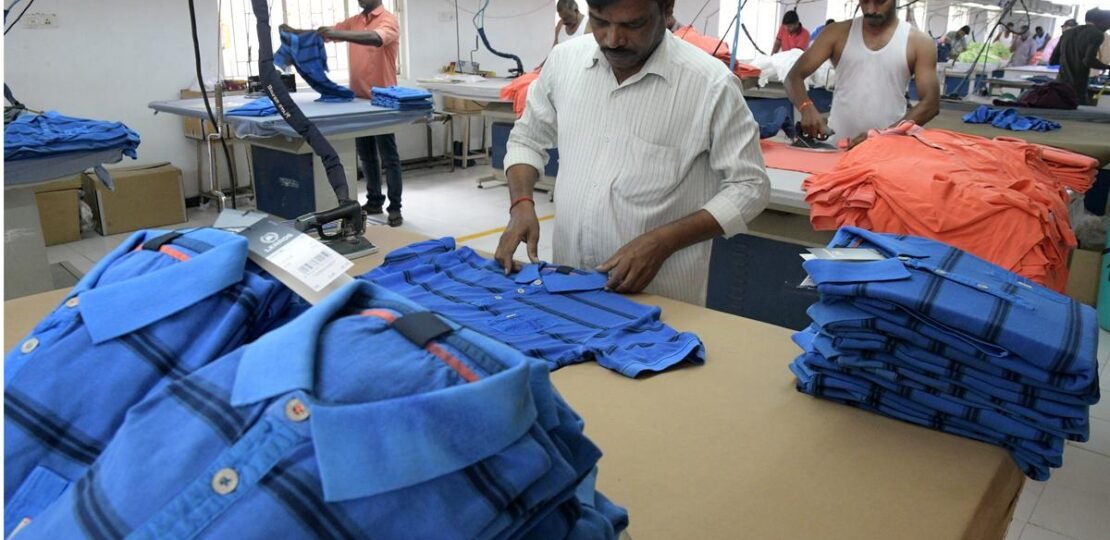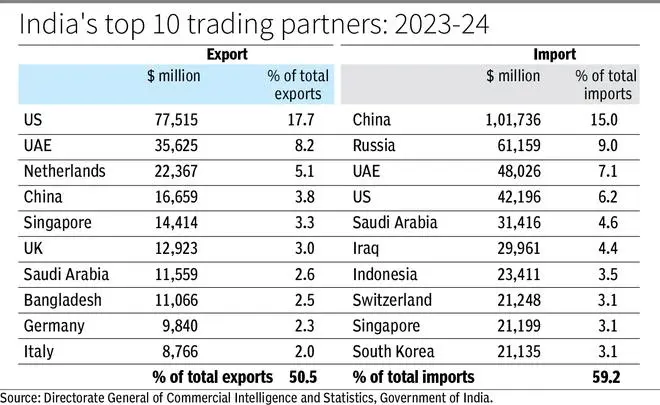

Textiles and apparel sector is likely to be impacted by Trump tariffs
| Photo Credit:
SIVA SARAVANAN S
On August 6, 2025, the US President Donald Trump signed an Executive Order, imposing an additional 25 per cent tariff on imports from India, effective August 27, 2025, due to India’s “direct or indirect import” of oil from Russia. This has legitimately created quite a fury in Indian media and policy circles, including calls as diverse as boycotting of US brands to speeding up a trade deal with the US.
In this context, the recently held meeting between US President Trump and Russian President Putin in Alaska on August 14 generated some positive sentiments in India. However, the meeting has not led to a breakthrough in the Russia-Ukraine war.
The direct implication for India is that the 50 per cent tariff rate imposed by the US President on Indian products may continue for some time. How far will India’s foreign trade be affected by the US imposition of tariffs?
Admittedly, the US is a major trade partner of India, accounting for 17.7 per cent of India’s total exports and 6.2 per cent of India’s total imports. A look at India’s exports to the US for the last two years suggests that the following product/product groups dominate India’s exports to the US: (1) electrical machinery; (2) pharmaceutical products; (3) precious metals; (4) mechanical appliances; (5) mineral fuels; (6) articles of iron and steel; (7) textile products; and (8) vehicles.
Therefore, a high tariff rate appears to be a significant blow to India’s export and growth potential. However, a few things need to be highlighted here. First, India’s top two export items are not facing the full brunt of this increased tariff. Pharmaceutical products are currently exempt from Trump tariffs, and there are conditional exemptions on semiconductors and electronic goods like mobile handsets. It is also notable that a 50 per cent tariff was already in place for imports of aluminium, steel, and derivative articles.
Secondly, for a few large export items from India, such as mineral fuels and items of precious metals, the gross export figures are a misleading indicator of domestic value addition because of a huge import content. For these sectors, even if the exports are hit, the impact on domestic value addition or GDP growth will not be as high as the gross export figures suggest.
Third, potentially, the most affected sectors seem to be textiles and apparel, as well as marine products from India. If we assume that a 10 per cent base tariff rate will be imposed on most countries, a 50 per cent tariff on India almost becomes a prohibitive tariff.
Possible solutions
So, we can broadly conclude that if the Trump tariff persists, then India’s merchandise exports to the US will face a significant problem. What are the possible solutions to this problem? One way to tackle the problem is to “jump the tariff wall” and produce in the US using FDI. This solution faces two issues:
First, the Trump tariffs are ad hoc and are introduced by executive orders and not through Congressional ratifications. These orders can be overturned if the President wishes. So, there is a high level of uncertainty associated with these tariffs, and companies will find it difficult to plan long-term investment in this regime of high uncertainty. This problem adds another layer to the complexities introduced by the recent US trade policies.
The second problem is that, generally, a strategy to use tariffs to encourage industrialisation is “tariff escalation”. Tariff escalation is a trade policy practice wherein a country imposes lower import tariffs on raw materials, higher tariffs on semi-processed goods, and the highest tariffs on finished products.
This strategy helps industrialisation by lowering the cost of importing inputs and making finished foreign goods more expensive in the domestic market, stimulating demand for locally made products. The Trump tariffs are not such a nuanced application of tariff rates. Therefore, Indian manufacturers cannot even source the intermediate goods from India to make the final goods in the US. Hence, relocating the value chain to the US, which is a country with very high wages, seems to be a challenging strategy for most Indian exporters.
The other option is to look for alternative markets if these high tariffs persist in the US. The latest data available for 2023 shows that India has a very low share in the global market for the above-mentioned commodities. The only possible problem is the product category of bed linens, curtains, and furnishings, where India has a share of 7.5 per cent in the global market. For the rest of the sectors, there is enough global demand to absorb exports from India. Therefore, in the medium to long run, if Indian products can remain globally competitive, then most of India’s merchandise exports can cope with the loss in the US market caused by the Trump tariffs.

This experience should also warn policymakers about the problems of high dependence on specific markets, especially in the backdrop of the ongoing geopolitical uncertainties. With the WTO all but rendered ineffective by the Trump tariffs, the focus should be on market diversification through forging and improving preferential and regional trade agreements with other countries. In this context, India’s regional policies like ‘Look East’ or ‘Focus Africa’ make sense.
Moreover, the de facto demise of the WTO opens up possibilities of more proactive industrial and trade policy measures for countries. India should seize this opportunity to enhance its competitiveness in merchandise trade by leveraging export and production incentives more effectively.
Pal is with the Indian Institute of Management Calcutta, and Ray is with the National Institute of Bank Management, Pune. Views are personal
Published on August 22, 2025
RELATED POSTS
View all



